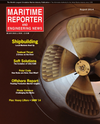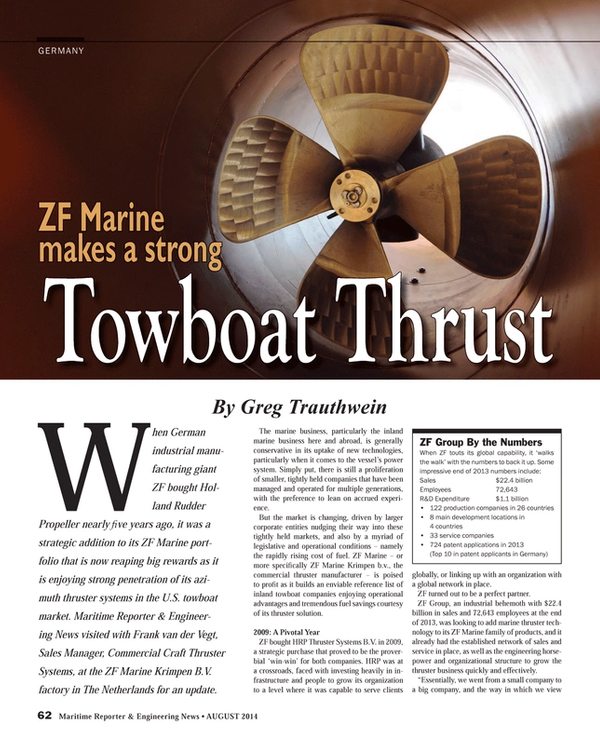
Permanent Magnet Technology for Maritime Propulsion
Multipurpose vessels, especially those that operate primarily at part loads, have been facing pressure when it comes to making money in today’s business environment. Returning to times of big profit margins will not happen soon without finding a radically different approach. Using permanent magnet technology for electric propulsion systems is a bold and proven way to save ship owners money due to lower fuel costs, less maintenance and fewer failures.
As cost pressures mount and environmental regulations become more stringent, the need for a novel and smarter approach is ever more apparent. This is especially the case for multipurpose service vessels that operate primarily at partial load conditions. Instead of tweaking conventional technology, such as induction motors, to try and invent a better solution, results prove that there’s a much better way to save on operational costs.
The Switch, using permanent magnet (PM) motors and generators as key elements in advanced drive trains allows ship owners to take advantage of a more flexible, modular, efficient and lightweight propulsion system.
Although new to marine applications, PM technology has in fact been a game changer for many years in other industries, such as wind power, where it ensures the highest energy efficiency and lowest costs of operation. As a bonus, this technology helps future-proof ships when it comes to even the strictest environmental legislation. For electric propulsion, PM technology based solutions are ideal for seafaring vessels, such as ferries, cruise lines, tugboats, offshore, research vessels, icebreakers and more. The technology enables ships to lower their operational costs by optimizing fuel consumption through superior efficiency, reliability and design flexibility.
• A synchronous PM machine contains Neodymium-Iron-Boron (NdFeB) magnets, which are materials with a very high flux density. This makes them ideal for variable speed motors and generators throughout the entire speed range. The magnet field is created with almost zero rotor losses.
• A PM machine gives high-efficiency performance over the entire operating range, significantly cutting back on fuel consumption. The PM machine is typically 2–4% more efficient at full load and 10% more efficient at part load when compared with induction machines. These efficiencies result from a lack of current losses in the rotor, the absence of an exciter, and reduced winding losses.
• PM propulsion motors and their inverters efficiently turn available energy into thrust, designed to deliver even higher efficiency in a much wider speed and torque range.
Lower Fuel Consumption
In a recent study of two 1250 kW diesel-electric propulsion trains, PM motors achieved an annual fuel savings of >3% with the same Z-drive thruster. PM motors also make it possible to use an L-drive thruster, which results in fuel savings by an extra >1%, along with length and weight savings thanks to the stacking ability.
Adjustable Speed Control
A frequency converter offers the accurate and adjustable speed control needed for dynamic positioning and demanding load cycles in offshore and special vessels. The high energy density of PM technology and resulting lower rotor inertia are beneficial when the ship needs high maneuverability and a DP class propulsion system.
This results in optimum fuel efficiency and lower levels of exhaust.
Highly pulsating power demand also poses a serious threat to the lifetime of a vessel’s engine. The ability to deliver to a combination of short full-power bursts and longer low-power demands is extremely wearing.
To handle highly fluctuating load cycles, guarantee longer engine life, cut back on fuel consumption and reach lower exhaust values, adjustable speed control is ideal. This avoids the low or no-load running of generators, which minimizes engine heat stress, reduces fuel consumption and eliminates undesired start/stop engine cycles.
Fewer Failures, Less Maintenance
In direct propulsion systems, no gearbox or accompanying slip rings and brushes are needed, as with other synchronous machines. Therefore, the PM propulsion line machine experiences fewer failures and requires significantly less maintenance.
PM solutions are compact, with lower weight and volume than conventional drive trains. They offer good flexibility and a smaller footprint for all types of configurations, especially when space is a critical factor. Additionally, PM solutions comply with low environmental footprint requirements.
By using a PM generator as part of a genset, significant weight savings can be achieved, and the total length of the genset can be reduced. On the propulsion side, using a PM machine as a propulsion motor combined with an inverter can lead to weight savings and switchboard length reductions.
Frequency Converters
The Switch frequency converters are optimized to work with PM machines for the best overall system efficiency. The electricity produced is of better quality with low flicker, reduced electrical noise emission and THD <1.5%. Additionally, PM drive trains have always demonstrated superior grid connection behavior, even in distributed environments. The frequency converter features a rugged IP54-class cabinet, which is a higher class to withstand the harsh sea environments. It can be easily accessed for installation and maintenance.
www.theswitch.com
The Author
Mika Koli, Business Development Manager at The Switch, is responsible for developing the marine business and applying the company’s permanent magnet drive train technology to advanced marine solutions.
(As published in the September 2014 edition of Maritime Reporter & Engineering News - http://magazines.marinelink.com/Magazines/MaritimeReporter)
Read Permanent Magnet Technology for Maritime Propulsion in Pdf, Flash or Html5 edition of August 2014 Maritime Reporter
Other stories from August 2014 issue
Content
- Editorial: software ... is it ‘evolution’ or ‘revolution’ ... page: 6
- Wishful Thinking From Across the Pond page: 8
- Panama Canal: The Billion Dollar Challenge page: 12
- OSV Power page: 14
- Polar Code Afoot page: 18
- Logistical Scenario Analysis for Hydrodynamic Applications page: 22
- Challenging the Myths of Pirate Violence page: 24
- Ballast Water Leadership page: 28
- Floating Production Roundup: August 2014 page: 32
- Keeping Machinery in Line with Laser Alignment page: 38
- Remote Diagnostics Help Drive Efficiency Gains page: 42
- News Flash! Greek Shipowners Prefer Bulkers page: 45
- Five Minutes with Gulf Copper’s Dennis Buffo page: 48
- BAE Systems Ship Repair: Leveraging Location, Infrastructure & Workforce page: 50
- Dry Dock Conference 2014 page: 52
- Spotlight on German Shipbuilding page: 58
- ZF Marine Makes a Strong Towboat Thrust page: 62
- Permanent Magnet Technology for Maritime Propulsion page: 62
- Ship Design and Construction Software Solutions page: 67
- Marorka’s Powerplay page: 72
- Indian Shipbuilding on the Road to Recovery page: 76
- Five Minutes with N-KOM CEO Abu Bakar Mohd Nor page: 80
- Realizing the Promise of Brazil Shipbuilding page: 84
- MTR 100: UTEC Survey Inc. page: 85
- ASRY All in on Project Jupiter page: 88
- Navantia Banks on the Future page: 89
- Energy Markets Buoy U.S. Shipbuilding page: 90
- Vigor: Frank(ly) Speaking page: 94
- Need a Lift? page: 96
- Dockside Load Testing with Unique Seaflex page: 97
- The Lowdown on Lifting page: 102
- SmartGrip: An ‘Evolution’ in Bulk Handling page: 104
- Shippers Must Reduce Costs, Boost Efficiency page: 106
- Fight Piracy – Intelligently page: 110
- Using HydroComp NavCad page: 112
- Keep it Clean & Green page: 114
- Victaulic Vic-Press System Receives Five New Type Approvals page: 119
- Bolidt Decking, Flooring page: 119
- Steering Alert System page: 119
- Bug-O Zipper Welder page: 119
- Envitia Launches MapLink Pro 8.0 page: 119
- Vosta LMG Delivers New Dredge Ball Joints page: 119
- Furuno Adds Color Display to NavPilot 700 Series page: 119


